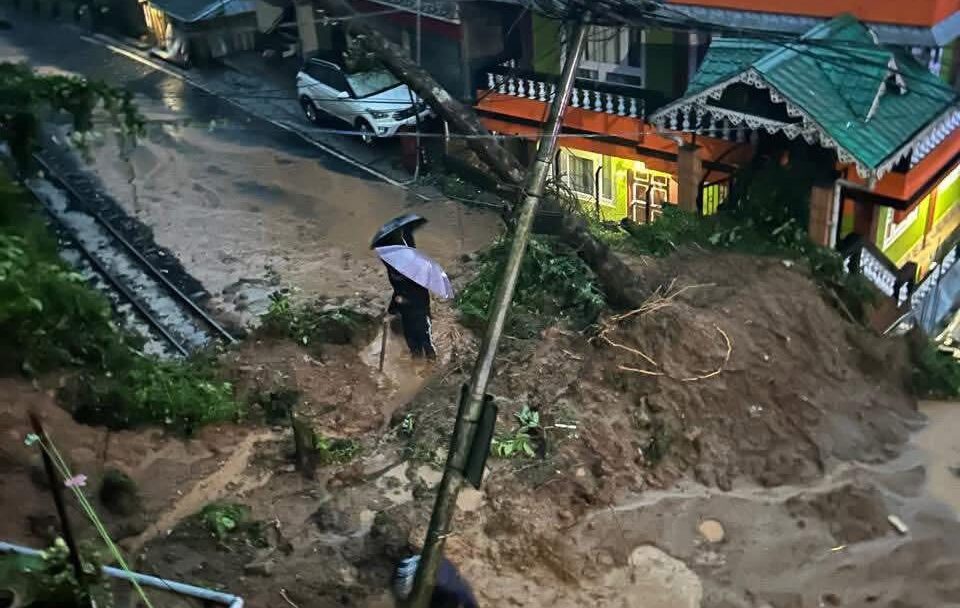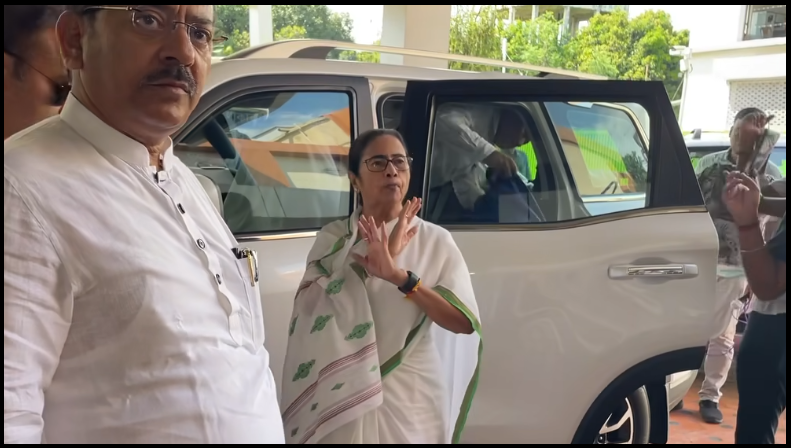
Darjeeling, Oct 6: Continuous heavy rainfall since October 4 has triggered massive landslides across Darjeeling and adjoining parts of North Bengal, leaving at least 23 people dead and dozens injured. Mirik has been identified as the worst-hit area, with 11 deaths confirmed. The calamity has caused widespread destruction of homes, roads, and bridges, cutting off several hill areas and severely disrupting communication and power supply.
National Leaders Express Condolences
The tragedy has drawn condolences from national leaders, including the President, Prime Minister, and Union Home Minister.
President Droupadi Murmu expressed grief on social media, stating that the “tragic loss of lives due to heavy rain and landslides in Darjeeling is distressing” and conveyed condolences to the bereaved families.
Prime Minister Narendra Modi wrote, “Deeply pained by the loss of lives in Darjeeling. The situation is being closely monitored. All possible assistance will be provided to the affected.”
Union Home Minister Amit Shah said he had spoken with Darjeeling MP Raju Bista to assess the ground situation. He confirmed that National Disaster Response Force (NDRF) teams had reached the affected zones, with additional units on standby.
State Government’s Response
Chief Minister Mamata Banerjee voiced deep concern over the heavy rainfall and resultant devastation. “We are saddened by the loss of lives due to sudden heavy rains in North Bengal. Immediate relief has been directed for affected families,” she stated. Banerjee held a virtual meeting with officials from five North Bengal districts and is scheduled to visit Siliguri and Darjeeling to personally review relief operations.
Sikkim Chief Minister Expresses Grief Over Darjeeling Flood and Landslide Tragedy
Sikkim Chief Minister P.S. Tamang has expressed profound sorrow over the devastating floods and landslides that have caused immense loss of lives and property in Darjeeling.
“I am deeply saddened to learn of the tragic floods and landslides that have brought untold hardship and suffering to the people of Darjeeling. My heartfelt condolences go out to all who have lost their loved ones and homes in this calamity. May the departed souls rest in eternal peace,” the Chief Minister stated.
He further added, “In this hour of great distress, I pray for strength and resilience for the affected communities to overcome and rebuild their lives. My sincere appreciation goes to all those involved in the ongoing relief and rescue operations for their tireless and selfless service.”
Assam CM Hemanta Biswa Sarma Expresses Solidarity with Darjeeling, North Bengal, and Sikkim Amid Flood Tragedy
Guwahati, Oct 6 : Assam Chief Minister Dr. Himanta Biswa Sarma expressed deep concern over the widespread devastation and loss of lives caused by incessant rainfall and landslides across Darjeeling and other parts of North Bengal. Conveying heartfelt sympathy to the affected families, the Chief Minister stated that the people of Assam stand united in this time of tragedy.
He assured that Assam is fully prepared to extend all necessary assistance to the Government of West Bengal in ongoing rescue and relief efforts.
Dr. Sarma further reaffirmed Assam’s solidarity with the people of Sikkim, who continue to face severe challenges due to floods and landslides. He said the Government of Assam remains committed to offering every possible support to help the neighbouring state overcome this crisis.
Rescue and Relief Operations
Inspector General of Police (North Bengal) Rajesh Kumar Yadav confirmed that 11 bodies were brought to Mirik Hospital, with several others injured in Sukhia Pokhri. “Roads remain blocked, and tourists are advised to stay indoors until clearance. Rescue teams from SDRF and NDRF are actively engaged,” he said. Community kitchens have been established to provide food and shelter.
MP Raju Bista, who visited affected areas, reported that the Dudhey bridge connecting Mirik valley to Siliguri has been closed due to damage. “Homes along the Dudhey, Panighatta, and Pankhabari belts have been destroyed. The situation is being monitored by the Prime Minister’s Office, and full support has been assured,” Bista said. He lauded local volunteers, police, and NDRF personnel for their “heroic rescue efforts.”
According to preliminary figures, landslides have struck 35 locations across the hills, destroying 37 houses and damaging 98 others. Eight roads have been washed away, five remain blocked, and two bridges have collapsed.
Local Administration and GTA Efforts
The Gorkhaland Territorial Administration (GTA) has been spearheading local rescue and relief initiatives. GTA Chief Executive Anit Thapa stated that community kitchens have been set up in Saureni and that displaced residents are being housed in rescue shelters. “We hope this disaster is declared a National Calamity to enable greater relief assistance,” he said.
Three relief camps in Mirik are currently housing 80 rescued individuals, while medical teams from Kurseong and Siliguri have been deployed for emergency treatment. Ambulances have transported four critically injured victims to North Bengal Medical College.
GTA officials Arun Sigchi and Amar Lama of the Bharatiya Gorkha Prajatantrik Morcha (BGPM) inspected the affected zones to coordinate food, shelter, and rehabilitation efforts. Authorities have urged residents to remain alert as more landslides are anticipated due to ongoing rains.
Ongoing Challenges
With key routes still inaccessible and infrastructure heavily damaged, restoration of communication, transport, and electricity remains a major challenge. Relief workers and volunteers continue to clear debris and deliver supplies to remote areas. Both the Central and State Governments have assured round-the-clock monitoring and full coordination between agencies.
As Darjeeling and its neighboring districts struggle to recover, the unified response from authorities, rescue forces, and community volunteers stands as a beacon of resilience in the face of this natural disaster.





